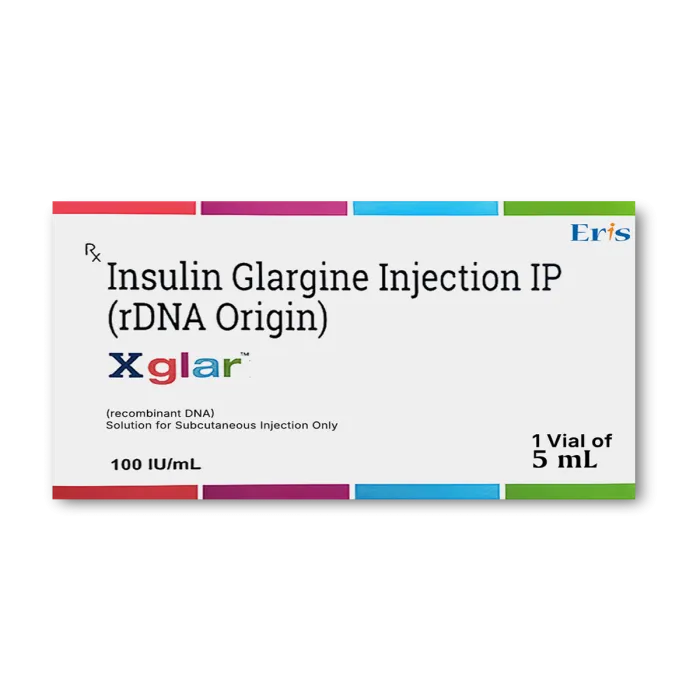Xglar Injection
What is Xglar injection
Xglar injection is a long-acting basal Insulin analog. It contains Insulin Glargine (100IU/ml) for comprehensive Diabetes management. This prescription medication provides 24-hour blood glucose control.
It is effective for individuals with Type 1 and Type 2 Diabetes who need Insulin therapy. Eris Lifesciences Ltd. manufactures this injection.
This synthetic Insulin analog mimics natural human Insulin production patterns to maintain stable glucose levels. Insulin Glargine has a modified molecular structure that allows gradual, consistent release over 24 hours without pronounced peaks.
The medication effectively prevents both Hyperglycemia and nocturnal Hypoglycemia. Common side effects of Xglar include injection site reactions, Hypoglycemia (low blood sugar), weight gain, and Lipodystrophy (abnormal fat distribution).
Store the injection in the refrigerator between 2-8°C and protect it from direct light. Never freeze the medicine or use it if it appears cloudy or contains particles.
Rotate injection sites regularly to prevent tissue damage. Patients should receive proper training on injection techniques and glucose monitoring. Regular follow-up with healthcare providers is essential for dose optimization and complication prevention.
What are the benefits of Xglar injection
Xglar delivers superior basal Insulin coverage through its unique peakless pharmacokinetic profile. Insulin Glargine forms microprecipitates at injection sites, allowing slow dissolution and sustained Insulin release.
This mechanism provides consistent glucose control without the pronounced peaks associated with intermediate-acting Insulin. Its benefits include:
- 24-hour basal coverage: Provides steady Insulin levels throughout the day and night with once-daily dosing.
- Reduced Nocturnal Hypoglycemia: Lower risk of nighttime low blood sugar episodes compared to NPH Insulin.
- Flexible dosing: Can be administered at any consistent time daily, improving patient convenience and adherence.
- Weight management: Better weight control than conventional Insulin preparations due to reduced Hypoglycemic episodes.
The predictable absorption pattern helps healthcare providers achieve optimal glycemic targets while minimizing glucose variability. It is crucial to note that Xglar requires proper injection technique and regular blood glucose monitoring for safe use.
How to take Xglar injection
This injection is a prescription medication that should be administered as per your doctor's instructions. Here are the general guidelines:
- Inject it subcutaneously once daily at the same time each day.
- Use proper injection techniques with insulin pens or syringes, as demonstrated by healthcare providers. Rotate injection sites between thighs, abdomen, and upper arms to prevent Lipodystrophy (abnormal fat distribution).
- Do not mix with other Insulin types or inject intravenously or intramuscularly. Do not exceed the prescribed dosage.
Strengths and substitutes
The strengths and substitutes available for Xglar at Cheap Medicine Shop are:
| Xglar One 100IU Prefilled Syringe | $21.63/pack |
| Xglar Refil Injection | $18.02/injection |
What are the side effects of Xglar injection
Xglar is generally well-tolerated when used appropriately. However, it may cause side effects, including:
- Itching
- Swelling
- Hypoglycemia with symptoms like sweating, shakiness, confusion, and rapid heartbeat
- injection site reactions, including redness and pain
- Weight gain due to improved glucose utilization and anabolic effects
- Lipodystrophy
Proper injection technique, site rotation, and careful dose adjustment can minimize these adverse effects. Seek immediate help if they worsen.
Safety Advice
![]() Liver disease
Liver disease
Patients with hepatic dysfunction require careful Insulin dose monitoring as liver disease affects glucose metabolism and Insulin clearance. Regular blood glucose testing is essential as Insulin requirements may decrease significantly. Healthcare providers should adjust doses based on liver function status and glucose monitoring results.
![]() Kidney impairment
Kidney impairment
Xglar injection dosing requires adjustment in patients with renal disease as kidney dysfunction prolongs Insulin action and increases Hypoglycemia risk. Frequent glucose monitoring is crucial as Insulin requirements typically decrease with worsening kidney function. Close medical supervision prevents dangerous Hypoglycemic episodes in these patients.
![]() Pregnant and breastfeeding women
Pregnant and breastfeeding women
Xglar injection can be used during pregnancy under strict medical supervision, as Insulin requirements change significantly throughout gestation. Regular glucose monitoring and dose adjustments are essential for maternal and fetal safety. Breastfeeding mothers may continue Insulin therapy but require frequent glucose monitoring as nursing affects blood sugar levels.
![]() Avoid
Avoid
Avoid alcohol as it might increase the risk of Hypoglycemia and mask warning symptoms of low blood sugar. Do not skip meals or exercise too much without adjusting Insulin doses accordingly. Avoid extreme temperature exposure to injection sites, as it may affect absorption. Never share injection devices to prevent infection transmission and cross-contamination.
FAQs
How should I store Xglar injection properly?
Store unopened Xglar injection in the refrigerator at 2-8°C. Once opened, it can be stored at room temperature for up to 28 days. Never freeze the injection or expose it to direct heat or sunlight.
What should I do if I miss my Xglar injection dose?
Take the missed injection dose as soon as you remember, then continue your regular schedule. Never double doses. Monitor blood glucose closely and contact your healthcare provider for guidance.
Can I mix Xglar injection with other Insulin types?
No, never mix Xglar injection with other Insulin preparations as it may alter absorption characteristics and effectiveness. Use separate syringes or injection pens for different Insulin types. Always seek a doctor's advice if using multiple medicines.
How do I know if my Xglar injection dose is correct?
Regular blood glucose monitoring, HbA1c testing, and clinical evaluation help determine optimal dosing. Work closely with your medical team to adjust doses based on glucose patterns. Never self-medicate or skip medical check-ups.
What are the signs of Insulin overdose?
Insulin overdose can result in severe Hypoglycemia symptoms, including confusion, seizures, unconsciousness, and rapid heartbeat. Seek immediate medical attention and consume fast-acting glucose sources if conscious and able to swallow.

